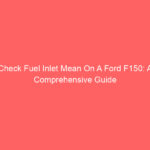Fuel issues can be one of the most frustrating problems for F-150 owners. A common alert that arises is the “check fuel fill inlet” message, indicating potential problems with the fuel system. Understanding this message is crucial to ensure your vehicle runs smoothly and efficiently.
As a seasoned automotive enthusiast, I can tell you that neglecting this warning can lead to serious engine issues. In this post, I will delve into the reasons behind the alert, its implications, and the steps you can take to address the issue effectively. By the end, you’ll have a solid understanding of how to keep your F-150 in optimal shape.
Key Points
- The “check fuel fill inlet” alert signifies issues with the fuel system.
- Common causes include a loose or damaged fuel cap.
- Ignoring the alert can lead to decreased fuel efficiency.
- Regular maintenance can prevent future issues.
- Understanding this message helps in troubleshooting.
- The problem may also indicate a need for a fuel system inspection.
- Quick fixes can often resolve the issue without professional help.
Understanding the Alert
When the “check fuel fill inlet” message appears, it typically indicates a problem with the fuel filler neck, cap, or the evaporative emissions system. This system prevents fuel vapors from escaping into the atmosphere, so any disruption can trigger the alert. It’s essential to understand that this warning is not just a minor inconvenience; it can impact your truck’s performance and fuel efficiency.
If the fuel cap is loose or damaged, air can enter the fuel system, leading to incorrect pressure levels. This may cause the engine to run inefficiently. Additionally, a malfunctioning fuel inlet can result in fuel vapor leaks, which are not only harmful to the environment but can also lead to costly repairs if not addressed promptly.
Common Causes of the Check Fuel Fill Inlet Alert
Understanding the common causes of the “check fuel fill inlet” alert is essential for diagnosing the issue. Below is a comparison table detailing some of the frequent culprits:
| Cause | Description | Symptoms | Solutions |
|---|---|---|---|
| Loose Fuel Cap | The cap may not be tightened properly. | Warning light on dashboard | Tighten or replace cap |
| Damaged Fuel Cap | Physical damage can prevent a proper seal. | Fuel odor or leaks | Replace the fuel cap |
| Faulty Fuel Filler Neck | Wear and tear can lead to malfunctions. | Fuel vapor leaks | Inspect and replace if needed |
| Evaporative Emissions System | Issues here can disrupt vapor containment. | Engine performance issues | Diagnostic check required |
| Fuel Pressure Sensor Malfunction | Can misread fuel levels and trigger alerts. | Erratic engine behavior | Sensor replacement needed |
This table highlights the need for vigilance regarding your F-150’s fuel system. Recognizing these issues early can save time, money, and potential hazards in the long run.
Steps to Diagnose the Issue
After receiving the “check fuel fill inlet” warning, the first step is to visually inspect the fuel cap. Make sure it is securely fastened. If it appears damaged or worn, replacing it is a straightforward and inexpensive fix. Most auto parts stores carry replacement caps specifically designed for F-150 models.
Next, check the fuel filler neck for signs of wear or damage. Look for cracks or loose fittings that could cause vapor leaks. If you’re unsure, consulting your vehicle’s service manual can provide insights into what to look for.
If the issue persists after addressing the cap and filler neck, consider conducting a diagnostic test. Many auto parts stores offer free scanning services to read any trouble codes your truck may have generated. This can provide additional clues about underlying problems, such as emissions system faults that may require professional attention.
Importance of Regular Maintenance
Regular maintenance is crucial for the longevity and efficiency of your F-150. By keeping up with routine checks on the fuel system, you can prevent the “check fuel fill inlet” alert from becoming a recurring issue. Regular maintenance not only helps identify potential problems early but also ensures that your truck operates at peak performance.
Consider incorporating a fuel system inspection into your regular maintenance schedule. This can be as simple as checking the fuel cap and filler neck during oil changes or having a comprehensive inspection performed by a professional mechanic.
Additionally, maintaining proper fuel levels, using quality fuel, and ensuring that your emissions system is functioning correctly can help avoid unnecessary alerts. A proactive approach will save you from inconvenient breakdowns and costly repairs.
Tips for Preventing Future Issues
Preventing future occurrences of the “check fuel fill inlet” alert involves a few proactive measures. First, always ensure that your fuel cap is tightened properly after refueling. A good rule of thumb is to listen for a click when securing the cap.
Second, regularly examine the fuel filler neck for signs of wear. If you notice any corrosion or damage, address it immediately to avoid major issues later on.
Furthermore, consider replacing your fuel cap every couple of years as a preventative measure. This is a minor investment that can save you from much bigger expenses if a leak occurs.
Lastly, keep your fuel system clean. Using quality fuel and adding fuel system cleaners periodically can help maintain optimal performance and prevent buildup that could lead to alerts.
Understanding the Risks of Ignoring the Warning
Ignoring the “check fuel fill inlet” alert can lead to several complications. One of the most immediate risks is decreased fuel efficiency. A faulty fuel system can cause your engine to work harder, leading to increased fuel consumption and higher costs at the pump.
Moreover, neglecting the issue can result in more severe engine problems down the line. Fuel vapor leaks can contribute to environmental pollution and may also trigger more complex engine diagnostics. Addressing this alert promptly can prevent further complications that might require expensive repairs.
Lastly, an unresolved issue could lead to failed emissions tests, making it difficult to register your vehicle. Therefore, it’s essential to take this warning seriously and address it as soon as possible.
Frequently Asked Questions
What does the “check fuel fill inlet” warning mean?
This warning indicates a potential problem with the fuel system, often related to the fuel cap or filler neck. It’s crucial to inspect these components to ensure proper function.
How do I fix the “check fuel fill inlet” alert?
Start by checking and tightening the fuel cap. If the cap is damaged or the alert persists, inspect the fuel filler neck and consider a diagnostic test.
Can I drive my F-150 with this warning on?
While you can drive it, ignoring this warning may lead to decreased fuel efficiency and more severe engine issues. It’s best to address it promptly.
How often should I check my fuel cap?
It’s advisable to check your fuel cap every few months or during regular maintenance intervals. Ensuring it is secure can prevent many fuel system issues.
What should I do if the problem persists?
If the alert continues after checking the cap and filler neck, consider taking your vehicle to a professional mechanic for a thorough diagnostic evaluation.
Conclusion
In summary, the “check fuel fill inlet” alert is a critical warning that should not be ignored. Understanding its causes and implications is essential for maintaining your F-150’s performance. Take proactive steps like inspecting your fuel cap and filler neck regularly.
If you encounter this warning, address it promptly to avoid complications. Regular maintenance and vigilance can significantly reduce the chances of future alerts. Remember, a well-maintained truck ensures reliability and efficiency for many years to come.
- Cost Replace Transmission On F150 Xlt - March 25, 2025
- Camshaft Position Sensor Bank 2 Ford F150 - March 25, 2025
- 99 Ford F150 4.6 Firing Order - March 25, 2025






